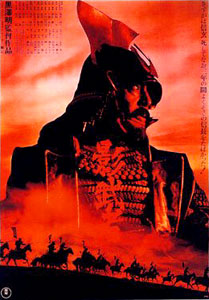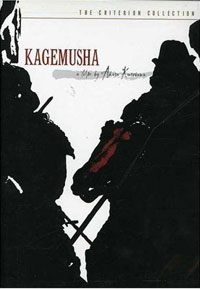 Kagemusha (Shadow Warrior, 1980) is set in 1573 during the warring clans period of Japanese history.
Kagemusha (Shadow Warrior, 1980) is set in 1573 during the warring clans period of Japanese history.
Lord Shingen Takeda (Tatsuya Nakadai) & his brother speculate that the lord's double (also Nakadai), found among criminal peasants, may have been their father's bastard. But as a peasant, they think of him as no more than a dog, speaking of him in his presence as though he can't hear or comprehend.
The Lord's brother Nobukodo Takeda (Tsutomu Yamazaki) had been serving as the Lord's double, but here in this grubby peasant, needing only to be cleaned up & costumed appropriately, is a true dead-ringer.
In the war between Oda Nobunaga (Daisuke Ryu) & Ieyasu Tokugawa (Masayuki Yui), we already know from history Nobunaga fails. Every scene, set, costume, & landscape concocted by Kurosawa to represent this world & its battles gets framed like a classic painting of well-known events.
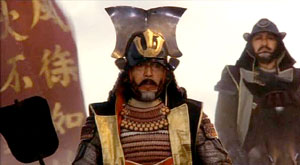 The great battle scenes are like unreal watercolors or a story-scroll unfolding, often shown in silence except for music, rather than the din of battle. And aftermaths of battle are like hell-screens one beside another. The great battle scenes are like unreal watercolors or a story-scroll unfolding, often shown in silence except for music, rather than the din of battle. And aftermaths of battle are like hell-screens one beside another.
Early in the tale, Lord Shingen is gotten by a sniper's arrow from a besieged castle. This leaves only his double to sustain a ruse required by Lord Shingen's closest followers. Until an outcome beneficial to the whole clan can be found, it must not be known Lord Shingen is dead.
Throughout this visually artistic but cold & distant tale, samurai on all sides are shown to be noble & idealistic even amidst cruelties, a weakness of Kurosawa's to invariably think so.
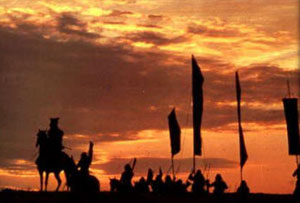 The shadow-lord gets to make a token statement of the hypocricies & villainies he perceives, but the weight of event & dialogue always favors samurai in any Kurosawa film, & even the passingly critical Shadow reveres Shingen's memory. The shadow-lord gets to make a token statement of the hypocricies & villainies he perceives, but the weight of event & dialogue always favors samurai in any Kurosawa film, & even the passingly critical Shadow reveres Shingen's memory.
And yet our peasant-cum-lord has not found his way into a paradise of noble warriors. As a chameleon, he is like a naive child on the dry riverbed of Emma's Hell, around whom horrors intensify.
At first the shadow-lord finds it all an absurd game. Those for whom he fronts despise him as lowborn, yet must in every public manner treat him as their lord.
Those who do not know of the deception, & never question his identity, worship his every twirl of mustache as that of a virtual god.
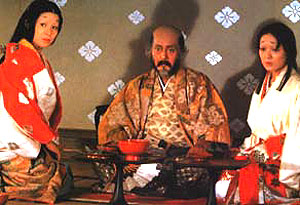 The conspirators fear the shadow's cameleonic ease will not be so faultless as to fool concubines. But fooling them is easier than it should've been if the story wanted to be fully credible; winning them over boils down to comic relief. The conspirators fear the shadow's cameleonic ease will not be so faultless as to fool concubines. But fooling them is easier than it should've been if the story wanted to be fully credible; winning them over boils down to comic relief.
But Shingen's little grandson Takemaru (Kota Yui) at first detected the change. Fortunately he soon convinces himself otherswise. Takemaru & the shadow become very close, troubling the brother Nobukodo since he knows the shadow must eventually be revealed for his imposture, & the child will be hurt by the discovery.
Those who know of the imposture & despise him as a peasant are easily stymied when the shadow begins to feel his oats, behaves as if truly their lord, & no one, however bitterly, dares disregard him.
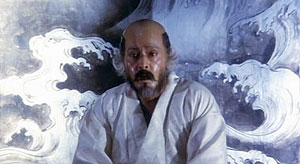 Close as it was convincing Takemaru, the problem of Shingen's favorite horse, which could tolerate no one but Shingen, is a bigger hurdle. Close as it was convincing Takemaru, the problem of Shingen's favorite horse, which could tolerate no one but Shingen, is a bigger hurdle.
The shadow, almost convincing even himself he is Shingen, believes he really can ride Shingen's horse. This attempt is the beginning of the end, as the secret at last becomes known to the concubine & others not formerly privy to the deception.
As the shadow becomes less & less likely to continue undetected, the necessity of his doing so simultaneously increases. Many enemies suspect the ruse, if for no other reasons than Shingen's warlord conquests have haulted & his clan sued for peace at a point when victory had been most certain.
Ieyasu Tokugawa's incursions against the domain of the Takeda clan increase because the warlord's prowess appears diminished.
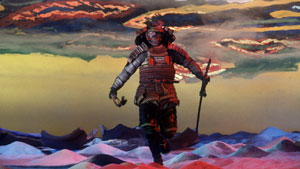 It comes down to a castle siege conducted by Shingen's imbittered son Katsuyori Takeda (Kenichi Hagiwara), while the shadow-Shingen sits like a lord overlooking carnage beyond his comprehension. It comes down to a castle siege conducted by Shingen's imbittered son Katsuyori Takeda (Kenichi Hagiwara), while the shadow-Shingen sits like a lord overlooking carnage beyond his comprehension.
The night-battle trying for the hill of Shingen's personal guard is especially spooky, with the brave deaths of the young pages an especial tragedy.
At last Katsuyori wins rule of his father's domain. The shadow is stripped of false honors & let loose, once more to become the base person he was born to be, not even allowed to say farewell to Takemaru.
Katsuyori begins open warfare against both Nobunaga & Ieyasu, with the released peasant now shadowing the endeavors like a ghost, deeply caring about events no longer requiring his assistance. Katsuyori oversees the end of the Takeda clan in one great battle.
And through a field of corpses of men & horses wanders the mad Shadow unbelieving, his own face painted like that of a corpse.
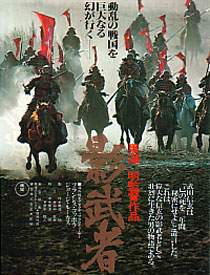 Despite epic grandeur in the battle scenes, Kagemusha has never been one of my preferred Kurosawa films.
Despite epic grandeur in the battle scenes, Kagemusha has never been one of my preferred Kurosawa films.
The emotions while expansive are never convincing as they are in Ikiru (To Live, 1952); the characters are never as strongly delineated or interesting as in Seven Samurai (Shichninin no samurai, 1954) or The Lower Depths (Donzoko, 1957); & no one character, not even the shadow-Shingen, possesses a captivating personality like we get from each of the Seven Samurai, or from Toshiro Mifune in Yojimbo (Bodyguard, 1960).
Tatsuya Nakadai is one of the world's great actors, but he has such a nobility of presence, he's never convincing as a peasant. The role was initially intended for Shintaro Katsu of Zatoichi fame.
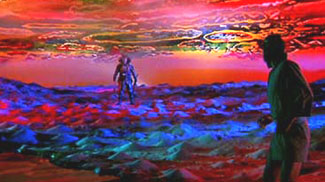 Katsushin would've been perfect, as he's massively capable of projecting himself as either the peasant or the lord. Katsushin would've been perfect, as he's massively capable of projecting himself as either the peasant or the lord.
But a combination of Katsushin's irresponsiblity, & Kurosawa's need to be treated as "taisho" or emperor, meant the prideful director & self-important actor clashed at once, being each too egocentric to bow to the other. So Nakadai was plugged into the role at the last minute. The film that might've been was never to be.
And yet it has to be acknowledged that the battle scenes are shocking, eerie, & grotesquely beautiful, outdone only by the battles we would see in Kurosawa's next film, Ran (1985) with vastly more realistic epic warfare.
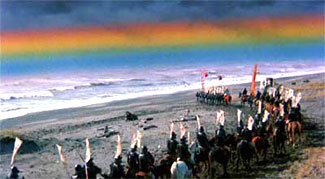 For Kagemusha there are scenes that wander entirely away from realism & look like comic book illustrations, or painted backdrops for a stage production. For Kagemusha there are scenes that wander entirely away from realism & look like comic book illustrations, or painted backdrops for a stage production.
Such artificial designs were taken directly from Kurosawa's overly elaborate storyboard paintings, & do closely reflect his skills as a painter.
These moments of expressionism reflect the dreamlike or nightmare perception of the Shadow Warrior himself, but have the effect of a mere stage play, if not manga.
Kurosawa's painterly eye had many years of planning out these sequences, while awaiting the chance to film the story.
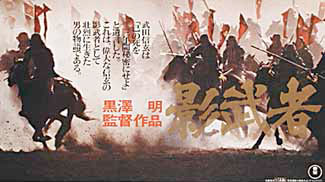 By the time he was able to begin filming with American investors, it had all become a little too solidified in his mind's eye. By the time he was able to begin filming with American investors, it had all become a little too solidified in his mind's eye.
Some of the imagery reached celluloid much too much like his paintings for these scenes, with poses of warriors more important than character or story, & color as exaggerated as in a paintbox, reminding us mainly that Kurosawa's greatest filmic achievements were in black & white.
Add to this the extreme make-up design for the Madness of the Shadow Warrior, taken right off the kabuki stage, & the artifice heightens. And really it should've relied on Nakadai's ability to act instead of so wholly on Kurosawa's ability to paint. Still, flaws & all, any suggestion that it's not a damned good film would be a mistake.
copyright © by Paghat the Ratgirl
|
